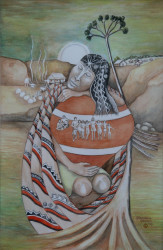Artists Stanley Greaves AA and Akima McPherson examine Stephanie Correia’s painting, Kabakaburi Music in this their ninth Conversation on Guyanese art. The watercolour was completed in 1998 and will be available for viewing from December 7 – 12 at the National Gallery, Castellani House.
Stanley Greaves: Kabakaburi Music by Stephanie Correia is titled after the Mission in the Pomeroon area. Correia herself was brought up at Santa Rosa. Her Dad made history by being the first Indigenous person to be appointed to the Legislative Council in the 1950s by the Governor. The painting is done in watercolours, not a favourite medium of artists, with good reason. Colours are affected by light, a serious problem in the tropics. Paper is also affected by mould and insects.
Akima McPherson: The medium of watercolour is indeed a difficult one requiring the layering of washes of colour – paint thinned with water, built up to suggest form and colour variations. Correia painted as a child and while at Teacher’s Training College in the 1950s was encouraged by E R Burrowes to focus her creative production on painting. From the early 70s she began to work with clay and around 1972 learned to throw on the wheel. Correia’s output in ceramic is well known and celebrated. Kabakaburi Music, for me, tells the Arawak creation myth, her story with art production as well as stories from her village experiences. The painting, therefore, simultaneously is based in mythology, the personal, and the historical. Interesting, it has never evoked the sound of music whenever I have stood before it.

SG: Her brother did write a very moving song. He is well known in the USA for his songs. Correia’s composition breaks a conventional rule not to have things placed in the centre. It is, however, not too noticeable because of areas of interest surrounding it filled with a village scene and figures engaged in everyday tasks. I was somewhat put off by the truncated legs of the figure. Was she involved in an accident or was it Correia not wanting to disturb the composition by having legs disappearing at the bottom of the page – a more acceptable option to my mind.
AM: Feet are difficult to render in two-dimension. I’m guessing she was shying away from them so she folded the legs under at the knee and cloaked them. I’m not sure that your proposal would have worked as it could have thrown the visual balance of the composition off. Anyhow, anatomy is clearly a problem and it is most obvious in the large figure. One needs only consider the parts of the body not visible and how they fit under the cloak and with the other parts we do see. But there is enough within the composition of a decorative nature to distract from this technical issue and truncated legs. I also would have liked her to not centre the painting around the central vertical axis. By doing that, Correia has made the painting restful and quiet, like an interlude. Consequently, I hear no music despite the drummers and dancers. The composition is nonetheless pleasing to me.
SG: Anything can be rendered two-dimensionally. The figure would work best if the garment was extended to the bottom along with the well rendered patterns. It would have Correia’s presentation reminds me of Rivera, the Mexican whose works emphasise two-dimensionality using a limited palette of colours.
AM: You are suggesting an entirely different figure – a standing figure. I saw the figure as seated hence my uncertainty. I’ll have to review Rivera’s work to see the connection.




